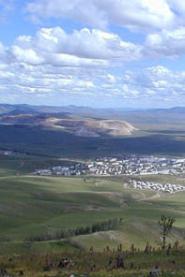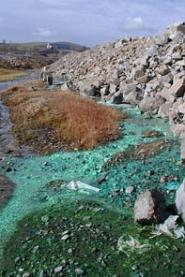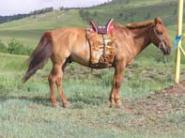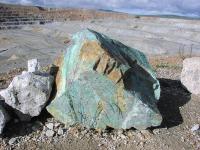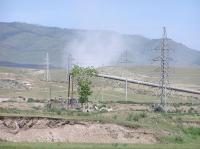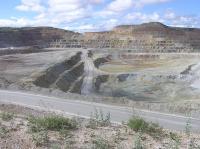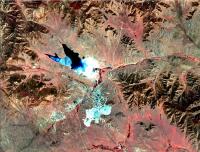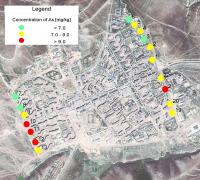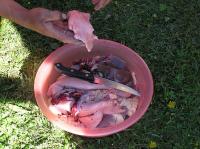ECOLOGICAL AUDIT OF THE ERDENET Cu-Mo DEPOSIT IN OPERATION, MONGOLIA
Contractor: GEOMIN družstvo, Jihlava
Project manager: Ing. Miroslav Žáček, PhD.
Cooperating organizations:
Project manager: Ing. Miroslav Žáček, PhD.
Cooperating organizations:
Partner organization in Mongolia: Ministry of Nature and Environment, Ulaanbaatar
Cooperating organizations in Mongolia: Mongolian Technical University, Ulaanbaatar
Cooperating organizations in Mongolia: Mongolian Technical University, Ulaanbaatar
Local authorities in the province of Erdenet and Selenge
The project is financed from the state budget of the Czech Republic under the Official Development Assistance Program of the Czech Republic
Project duration: 2003 - 2005
The town of Erdenet is located in the central part of Mongolia close to the border with the Russian Federation. It is named after the Erdenet porphyry copper deposit, one of the largest in the world. The credit for the discovery of this deposit belongs largely to the Czech geologist Dr. E. Komínek. Mining operations at this deposit go back to the year 1978 and are anticipated to continue at least until the year 2020. A Mongolian-Russian Company GOK Erdenet (joint venture) is engaged in mining of the deposit. The copper production from Erdenet is of great importance to the Mongolian economy, contributing a significant proportion of the gross national product. However, as in all cases of human intervention in nature, the local mining, mineral processing and waste disposal have a negative impact on the local environment. The possible impacts include contamination of soils, of surface and ground waters, and the dispersion of dust in the atmosphere, and entry of harmful elements into the food chain, etc.
A project entitled „Ecological audit of the Erdenet Cu-Mo mining operation, Mongolia“ was proposed by GEOMIN company and implemented within the Official Development Assistance Program of the Czech Republic.
Erdenet info
Information about the GOK Erdenet mining and mineral processing company is available on www.emc.erdnet.mn
Long-term objectives of the project
A project entitled „Ecological audit of the Erdenet Cu-Mo mining operation, Mongolia“ was proposed by GEOMIN company and implemented within the Official Development Assistance Program of the Czech Republic.
Erdenet info
Information about the GOK Erdenet mining and mineral processing company is available on www.emc.erdnet.mn
Long-term objectives of the project
- sustainable development of mining for copper ores
- improvement of living conditions for the local population
- promotion of uncontaminated agricultural production
- improvement of quality of surface and ground waters
Immediate objectives of project
-
Acquisition and integration of all data relating to the Erdenet deposit (results of exploration projects, geological structure of the deposit, its mineralogical and geochemical characteristics, hydrogeological conditions in the mine and its environs, applied methods of mining and mineral dressing, system of ecological monitoring)
-
Definition of possible dangers connected with mining and mineral processing operations
-
Identification of the most serious but so far unsolved problem
-
Choice of a suitable methodology for resolution of the problem
The project was scheduled to be carried out over three years from 2003 – 2005. After evaluation of all data the most serious environmental need was identified as: Monitoring of aeolian transport of of agriculturally exploited soils and on the possible entry of transported elements (in particular Cu and Mo) into the food chain.
The research was based on ecological-geochemical investigation in the environs of the mining and mineral processing facilities at the GOK Erdenet deposit. This was supplemented by hydrogeological surveys and interpretation of satellite images. Numerous samples of various types were collected in order to characterize the distribution of harmful elements in various sectors of the environment. The following materials were collected:
-
Special samples (samples of mud from tailings pond, samples of transported material, samples of coal from the local municipal heating plant)
-
Samples of stream sediments to test for possible contamination of fluvial deposits
-
Soil samples at sites downwind from the mining and processing plant
-
Samples of surface waters
-
Samples of grass and agricultural products
-
Samples of animal tissues(muscle, liver and lung of domestic cattle, and human hair)
Measurements of selected physical-chemical parameters indicative of water quality were also carried out (pH, oxidation-reduction potential, electrical conductivity, amount of dissolved oxygen, temperature).
All samples collected were analyzed for a range of harmful elements, selected stream sediment samples were tested using sequential analysis to determine the order of release of individual elements from their mineral carriers into the aqueous environment.
All samples collected were analyzed for a range of harmful elements, selected stream sediment samples were tested using sequential analysis to determine the order of release of individual elements from their mineral carriers into the aqueous environment.
RESULTS OF INVESTIGATION
Based on evaluation of field observations and analytical results, the sources of pollution were identified. These were found to contribute much more contamination to the environment than dust particles from the tailings pond. The entry of some harmful elements into the food chain was also demonstrated.
The entry via soil is less pronounced and occurs only up to a maximum distance of 2 km southwestward from the tailings pond. On the other hand, the direct entry of harmful elements into the food chains occurs via air pollution. Dust particles containing toxic elements may have an unfavorable effect up to a distance of ca 5.5 km from the source of pollution. However, no negative impact on the health of the local population or domestic cattle was observed, except in the specific area around the dam of the tailings pond.





